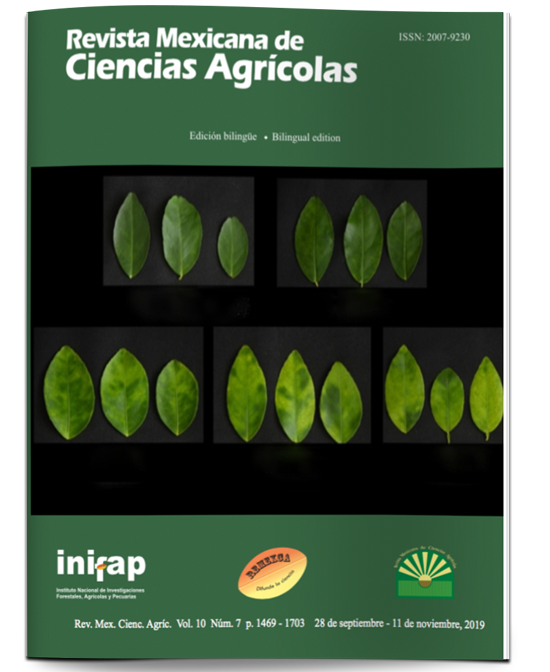Total sugars and protein in beans native to the Triqui Alta region, Oaxaca
DOI:
https://doi.org/10.29312/remexca.v10i7.2114Keywords:
Phaseolus vulgaris, P. coccineus, bean compounds, color of the testaAbstract
Sowing bean compounds, which combine sizes and colors, is a cultural tradition in rural Mexico, used primarily for self-consumption. Bean blends have a visual appeal; however, little is known about the characteristics of flavor and nutritional value represented by this way of consuming beans. The objective was to know the content of protein and total sugars in native bean compounds from the Triqui Alta region of Oaxaca. In 2017, the study of three bean seed samples was carried out. Bean color was determined visually and the weight of 100 grains was measured. The total sugar content was determined with the Antrona method, and the protein content with the Kjeltec semi-automated equipment. The analyzes were performed in duplicate. In each sample at least 4 different colors and grain sizes identified as common beans (Phaseolus vulgaris L.) and ayocote (Phaseolus coccineus L.) were identified. The sugar content in medium grains was 6.17 to 6.48%, while, in large grains, -ayocote-, it was from 9.45 to 11.6%. Protein content varied between subsamples from 21.7% in black P. coccineus, to 24.8% in yellow P. vulgaris. Grain color was not associated with protein or total sugar content; however, the grain size does. A larger grain size, higher percentage of sugars (r= 0.88**) and lower protein content (r= -0.61*).
Downloads
Published
How to Cite
Issue
Section
License
The authors who publish in Revista Mexicana de Ciencias Agrícolas accept the following conditions:
In accordance with copyright laws, Revista Mexicana de Ciencias Agrícolas recognizes and respects the authors’ moral right and ownership of property rights which will be transferred to the journal for dissemination in open access. Invariably, all the authors have to sign a letter of transfer of property rights and of originality of the article to Instituto Nacional de Investigaciones Forestales, Agrícolas y Pecuarias (INIFAP) [National Institute of Forestry, Agricultural and Livestock Research]. The author(s) must pay a fee for the reception of articles before proceeding to editorial review.
All the texts published by Revista Mexicana de Ciencias Agrícolas —with no exception— are distributed under a Creative Commons License Attribution-NonCommercial 4.0 International (CC BY-NC 4.0), which allows third parties to use the publication as long as the work’s authorship and its first publication in this journal are mentioned.
The author(s) can enter into independent and additional contractual agreements for the nonexclusive distribution of the version of the article published in Revista Mexicana de Ciencias Agrícolas (for example include it into an institutional repository or publish it in a book) as long as it is clearly and explicitly indicated that the work was published for the first time in Revista Mexicana de Ciencias Agrícolas.
For all the above, the authors shall send the Letter-transfer of Property Rights for the first publication duly filled in and signed by the author(s). This form must be sent as a PDF file to: revista_atm@yahoo.com.mx; cienciasagricola@inifap.gob.mx; remexca2017@gmail.
This work is licensed under a Creative Commons Attribution-Noncommercial 4.0 International license.



